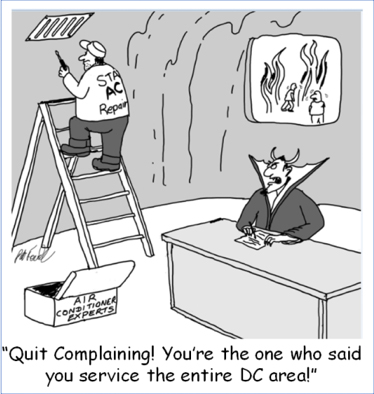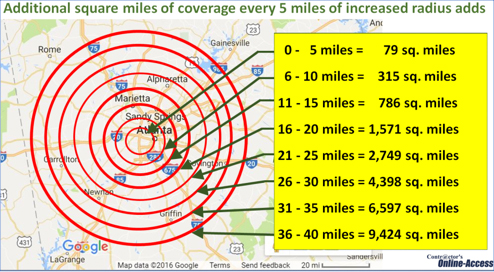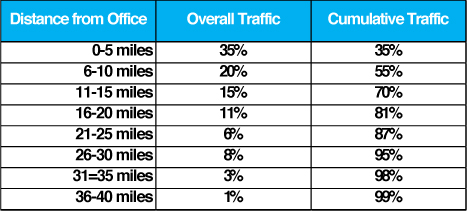Although it sounds great when people say the beauty of the Internet is that it lets you connect to everyone and everywhere, for a contracting business this statement has absolutely no connection with reality. Sure, your website can be found by a remote villager in Indonesia if he has a smart phone and WiFi conveniently available—but so what? We both know that he is obviously not your customer. You don’t have to be a Rocket Scientist to intuitively understand this, and it’s no big deal whether he finds you or not since you spent absolutely no money or effort trying to get him to find you. Where the water gets murky (and expensive), is when the discussion turns to getting the guy 25 miles away, living three towns over, to find you. At this point, we probably will have a disagreement.
Now mind you, if the guy three towns over and 25 miles away calls you and you have the excess capacity to service him, go for it. However, deliberately incurring marketing expense to get that guy to call you is probably not the best use of funds. You see, he may be within the radius of your Service Area, but for the majority of companies under 5 million in sales, I would argue that he’s probably not even close to being in what you should be considering as your Marketing Area. In fact, the inability for contractors to differentiate between their Marketing Area and their Service Area is probably the biggest trap into which I see contractors fall.

The problem is, when a contractor first goes into business, his definition of a potential customer is; “everyone who has a driveway and a decent checkbook.” (It’s important to note here, that the ones that don’t survive their first year in business are the ones that focused only on the driveway part) After our typical ‘budding’ contractor begins to grow—or runs his first two warranty calls over 40 miles from home, he has a brilliant idea and decides that maybe he should draw a circle on a map with a 20 to 25 mile radius from his office, and only take calls within that circle. Instinctively, he titles his stroke of genius, “My Service Area!”
Unfortunately, as our growing contractor gets bigger, he eventually realizes that he needs to market his services to keep growing. When asked exactly who he should market to, being the shrewd businessman that he is, he now defines his target customer as; “everyone who has a driveway, a decent checkbook, and lives within the cool circle I drew on my map!” After all… it’s obvious that that is who he should market to, since that is his company’s Service Area. At this point our contractor has officially fallen into a mindset that will not only bring him much frustration, but tremendous costs as well. So let’s take a look …what’s wrong with this mindset?
What a 25 Mile ‘Service Area’ actually Represents
First off, the costs of successfully marketing even a 25 mile radius are beyond the typical contractor’s budget (the operative word here being “successfully”). You need to understand that a 25 mile service area translates into 2,749 square miles. If your company is located in North Dakota where the population density is 10 people per square mile, you could probably adequately market to all 27,490 people in your 25 miles. However, to market everyone in a 25 mile radius in New Jersey, you’d be trying to market to 3,348,282 people, or 1,235,528 homes according to NJ’s average household size. Even if you sent each home one 50-cent post card, you’d have a $617,000 mailing. Even in a farm state like Iowa, with an average of 60 people per square mile, you would have to market to 68,000 homes just to touch everyone once. If you find it hard to believe that your 20-25 mile radius is typically too large an area for a small

company to market to, here’s a tool to actually see how many people are in your Service Area, and here’s a page with each state’s average household size, so knock yourself out.
My point is to, hopefully, get you to see exactly how big a 20-25 mile Service Area is, and how unlikely it is that you can afford to market to it well. However, at this point, contractors are typically saying to themselves, “Well, I sort who I market to by income, so I don’t waste money mailing to everyone.” This is true to some extent, but even though you may only be marketing to affluent households in the additional 2,000 square miles beyond a 15 mile radius, I’ll bet dollars to donuts that your ROI on this marketing is absolutely dismal compared to what you get within the first 10 miles. How do I know this? It’s simple. Unless you’re the local marketing powerhouse and have a huge marketing budget, anytime you market beyond 10-15 miles from your office, you’re fighting against the familiar.
Understanding the Power of Familiarity
As a contractor, the problem with marketing is that the further you go out from your office, the more costly it becomes to compete with the guy everyone’s familiar with who’s already there. To show you how proximity to a customer affects your business, here is a study our company did a year ago regarding how geography affects HVAC Web Marketing. In our study, we examined a random sampling of 43 single-location contracting companies, from July of 2015, to July 2016, to see where the visitors to their sites came from. The sample data utilized over 95,000 valid website visits generated within 100 miles of their location.

The chart here showing our findings is a pretty good example of how proximity affects a contractors marketing. As you can see 55% of all visits to a company’s website originated within 10 miles of the company’s location. The number jumps 15% to a total of 70%, within 15miles of the contractor’s address. Of course, it can be argued that this only represents how Search Engine Optimization has become more difficult the further you are from the target area. However, during the period of this study, the majority of the companies used were subscribed to our Nearby Now program and were showing up on the first page in most of the cities in their Service Area—with stars by their website listing.
However, this is not the only reason I’m suggesting that your actual Marketing Area needs to be a smaller subset of your Service Area. In 2015, we launched a new exclusive service called our MORE Program that’s been very successful. In this program, we help develop, create, deploy, and systematize a company’s entire marketing plan and strategy. When we take on a client, we initially do a complete database analysis of all their sales for the previous five years. Invariably, we find that although they have been marketing to more than 30 zip codes, 70-80% of their sales will come from just a small fraction of the total. The zip codes that comprise the majority of these company’s sales are typically zip codes that are very close to them and, by definition, should be seen as the company’s true Marketing Area. To prove this to yourself, all you need to do is a simple breakdown of where your last year’s annual revenue came from by zip code. I guarantee that you’ll discover that where your marketing is the most successful is only a small part of what you consider your Service Area.
So, Why should I Market Where I’m already Doing Well?
To put it simply, your marketing will be a lot more successful and give you a greater return on investment. Think about it, aren’t you more likely to open a letter from a business you’re familiar with rather than one you’re not? When you’re doing a search for a local service that you don’t have any experience with, do you just pick the top listing or do you scan down the entire first page to see if something familiar jumps out at you?
If you’re like the majority of the population, the familiar always wins. Why? Because when a person is looking for something they have no experience with, there is always that fear that they could choose wrong. They are looking for something to grab onto. This is probably the biggest reason why over half of a company’s web visitors are located within 10 miles of the company’s address. Everyday your trucks leave and come back to your office. The odds of constant exposure to your brand only increase the closer they are to your office. Choosing a company they recognize makes them feel that much more secure in their choice.
The benefit to this approach is that growth breeds growth as you begin to own your Marketing Area, and it starts to expand naturally into your Service Area. Best of all, you do it with greater profitability. Not only is it more profitable because it minimizes non-productive windshield time, it also stops you from wasting marketing dollars in communities miles away, trying to get people totally unfamiliar with your company to choose you over the guys they see every day who are located closer.
Until next time— dave
Please address all comments or questions regarding this or any other articles in our newsletter to articles@online-access.com.
